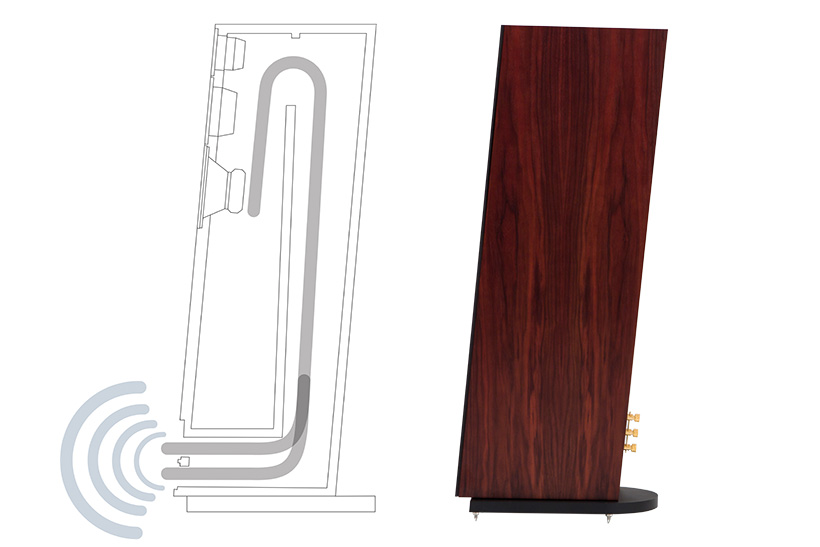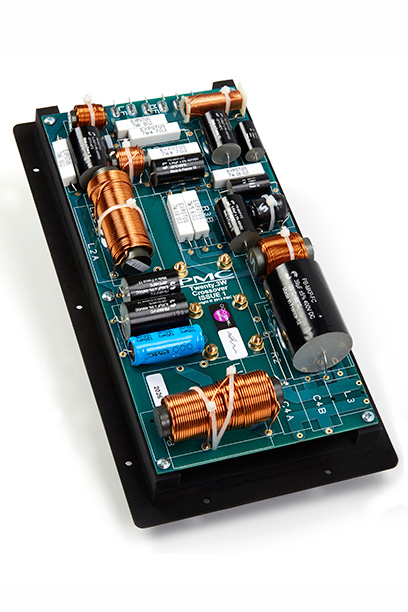In an attempt to foil my fellow reviewers and audio loving friends I got my hands on one of the very first pairs of PMC twenty.26 loudspeakers that came to the Netherlands. This model was introduced to mainland Europe at the High End Show 2014 in Munich and is the latest member of the twenty family, the successor to the very successful OB1. The twenty series starts with the .21 and .22 bookshelf designs, then the floor standing .23 and .24 come in, together with the twenty-C (centre). The twenty.26 is the first three-way in the range and sports one of PMC’s much lauded midrange domes on its front baffle.
For those unfamiliar with the Professional Monitor Company here is a short introduction. Company owner Peter Thomas developed a loudspeaker system for the BBC in the late eighties. He was at the time employed by that same BBC and had to make a choice: stay with BBC or start an uncertain future as loudspeaker manufacturer with co-founder Adrian Loader. Fortunately for us he chose the latter, at first for studios but soon domestic loudspeakers appeared as well, albeit with the same character as the pro models. When PMC celebrated its twentieth birthday the twenty series was introduced to, and garnered awards from across the reviewing universe. This introduced the brand to a wider public and resulted in the company growing in a shrinking market. Quality rules as they say.
The twenty.26 has the same elegant appearance as its sister speakers. The backward leaning enclosure has a thick and heavy base with spikes to pin the speaker to the floor. When the magnetic grille is removed the twenty.26 doesn’t look like so many other speakers, because of the two domes; one tweeter, one midrange. Below both we have a transmission line loaded woofer. The tweeter and bass unit are co-engineered with SEAS to PMC’s design. The Sonolex dome tweeter is used in all other twenty models, new is the PMC’s 50mm twenty series dome midrange which features a dispersion grille similar to the tweeter. This is not only for protection as I thought, but to improve dispersion. The bass unit has an unusually large dust cap for PMC that covers a lot of the doped cone. The ‘advanced transmission line’ (ATL) behind is 3.3 metres long. A transmission line is a critically damped, tapered tunnel that becomes narrower toward the vent, it absorbs unwanted energy and helps to lower the resonant frequency of the bass to 28Hz. The double port opening of the line was first seen on the fact.12.

Don’t think of transmission lines as being slow, the days of IMF are far behind us now. A well designed line is just as fast as any other loudspeaker type, in fact it sounds faster than most reflex systems. The twenty.26 has a unusually complex 24 dB/Octave crossover that will make a lot of loudspeaker designers jealous. The midrange dome operates between 380Hz and 3.8kHz and you can directly drive this part of the system via tri-wire terminals on the back. PMC recommends amplifiers rated at at least 50 Watts per channel, a wise choice since the efficiency is a low 86dB.
Being aware that not everyone has a first class high end amplifier at home but still wants to take advantage of a fine pair of loudspeakers I first use the twenty.26 in my smaller system. It comprises a Naim UnitiQute, in use as streamer/preamplifier, with a NAP 100 connected for power. This small amp delivers 50 Watts and in a small room this should be more than sufficient. My own twenty.23s, the smaller floor standing types are set aside for the review. Even a mid quality CD like Unplugged from The Corrs shows right from the start how much a good midrange dome can do for the stereo image, definition, transparency and credibility of a loudspeaker system. The female voices are unified yet in every one the personal character is easy to recognise. Other members of the band are positioned around the sisters in the soundstage, like a wall reaching just outside to the left and right of the loudspeakers, but without any depth. It’s totally different from the stereo image Melody Gardot offers in this setting. The image is far livelier, a lot wider, far deeper and placed at the correct height. So do not blame the .26 if the stage is disappointing. Melody is singing with great joy, showing emotion and happiness in her voice. If The Stars Were Mine makes me so happy that I have to play at least Les Étoiles too. This second track contains far more bass energy but still I can play it loud enough without overblowing my room. As usual the advanced transmission line design shows many advantages over most ported types. I love the happiness in music coming from the .26, it seems likes all artists perform with a smile on their face. Talking about lady singers we need to play The Changing Lights form Stacey Kent. Music splashes all over the room, piano leading the voice through the song. The moment drums, bass and more instruments join it seems like curtains are lifted from the stage to unveil the band. I enjoy the separation between instruments since every instrument attracts my attention in a different way. The performance is not only playful, at the same time it is snappy, fast and rhythmic. Rhythm is of course a typical habit of Naim amplifiers, still a loudspeaker must be able to translate this property in the right sense and not fall asleep during the process. Diversions into other music styles like baroque, opera, jazz and male singers offer me enough pleasure to make it less and less attractive to swap my fact.12 in my large listening area for the twenty.26 under review. A place where not too long ago some fact.8 had been in residence, but a man has to do what a man has to do.

Although the power rating of my Audia Flight 50 amplifier is on paper just the same as the NAP 100, the 50 is far more able to deliver current when the the speaker requires. The other components in this large system, like preamp, sources and cabling leave a Naim UnitiQute with NAP 100 standing in the shadows. Modern times are here, therefore the main digital source is my streaming NAD M50/M52 combination, digitally connected to an Aqua La Scala digital to analogue converter. An expensive record player is on hand to play through an Audia Strumento No.1 preamp. Mains power is cleaned using filters on a dedicated spur. Cables are manufactured by Crystal Cable, except for my Yter XLR interconnects. Playing the system my first CD comes from Silje Nergaard, titled At First Light, and it hits the bull’s eye. Silje’s voice flows into my veins, supported by piano, bass and saxophone without the slightest effort. I immediately notice the greater conviction a class A power amplifier brings, the sound escapes the baffles in a fashion that’s comparable to the fact.8 and .12. Silje’s voice is in the middle, alongside a piano with drums positioned in the background and bass flowing all over the stage. Next to a stereo image with depth, the correct height adds to my listening pleasure. Sitting on the couch Silje is standing up in front of me, lesser speakers might keep her voice along with the instruments at tweeter level only. The first and second voices are intelligible all the way through the songs.
Ray Charles once made a wonderful CD entitled Genius Loves Company, where he sings along with big stars like Diana Krall and Natalie Cole. These duets offer a perfect comparison between male and female voices, showing any gap in the frequency response very easily. The twenty.26 has a perfect balance in this regard, showing again how well a transmission line couples to a room no matter what size it is. The track named Fever is a joy to listen to, thanks to Miss Cole who eagerly rebuts Ray in the duet. Sticking to male voices and adding acoustic instruments I choose Paul Stephenson (not the MD of Naim audio I take it! Ed) and his fine album These Days. Suppleness is the most apt word to describe the result. His easy voice with guitar back up sounds very natural, a touch of warmth adds even greater listening pleasure.
 |
 |
No way can a twenty.26 dodge a comparison with the similarly priced PMC fact.8. Well, the fact.8 is the more precise loudspeaker, the one that resembles PMC studio monitors the most. It is the more purist of the two, adding nothing to what it is offered. The twenty.26 does hide a little, but has a wider bandwidth and adds a bigger fun factor. It’s an all round type that remains loyal to the pro audio background of the designers. That way the two models differ much more than on retail price. The midrange dome has a lot to offer and might give the twenty.26 an advantage over the fact.8 for a wider public. All those who eagerly listen to voices will be very happy indeed. Because of the impressive replay of voices and acoustic instruments I put on Troubadours On The Rhine, a performance by Loreena McKennitt for German radio. Her unique voice accompanied by only a single a cello fits like a glove in the dark impression of The Wind That Shakes The Barley. I can play it loud during the day or soft when my neighbours are asleep, in both cases I get all information I need. But playing a bit louder is more fun with the .26.
During a musical journey through my CD and LP collection the PMC twenty.26 shows its range of ability. The reproduction of music is pleasurable and at the same time accurate, without emphasising inner detail like some speakers do, losing sight of what they are made for in the pursuit of technical perfection. If you are looking for a more exact sound turn to the fact series. The twenty.26 must be positioned in the pleasure dome, forgiving when the recording is less than perfect, excellent when the mastering is heavenly. The twenty.26 is easy to position and, as a result of the transmission line, bass is tight and controlled, seemingly going deeper than physics allow. The synergy between the drive units is excellent too, listening off axis turns the twenty.26 into a point source.
No hard criticism at all? No, I cannot find fault, simply stated this speaker is very nice company in a world where seeking the tiniest details can lead to excessive behaviour, a scanty midrange, too much bass and ear tiring tweeters. Right from the start his speaker makes you want to listen for hours and hours. It reproduces voices and instruments in a very natural way, always faithful to its pro monitor heritage and the joy of music.


